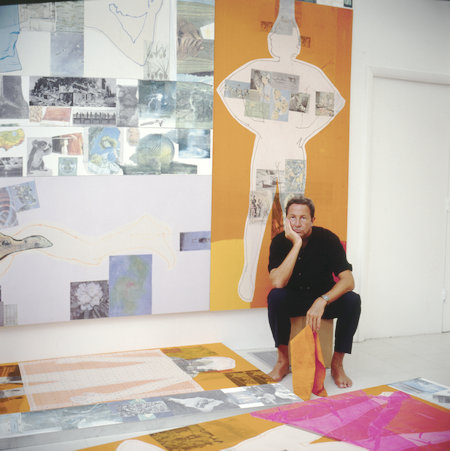 |
|
Robert Rauschenberg works on The 1/4 Mile or 2 Furlong Piece (1981-98) in his studio in Captiva Island, Florida, around 1983. [Photo provided to China Daily] |
Through the lens of his Hassleblad camera, Rauschenberg offers glimpses into the daily lives of ordinary Chinese in the early phase of the reform and opening-up, with a focus on the changing urban landscape.
In a Chinese catalog for his 1985 exhibition, Rauschenberg wrote-based on his wide travels and collaborations in many places-that he believes one-on-one contact through art is a powerful way to promote peace.
"Maybe art is not well understood by people at the beginning, but it is educational, interesting and inspiring," he said.
He added that being able to share distinctive features brings people closer. And he says it was not until he came to see the differences that he became an artist who knew how to look at the world, and the Rauschenberg Overseas Cultural Interexchange provided him the opportunity to observe these differences.
Christy MacLear, executive director of the New York-based Robert Rauschenberg Foundation, who was at the opening of the current exhibition, says the artist is "well known as a champion who believes that art transcends words, boundaries and borders".
His trip to China introduced him to the beauty and majesty of its culture and people, she says, and his travels to Cuba, Russia and Mexico engaged different cultures, making him a "global artist", which was rare in the 1980s.
The current exhibition also celebrates the opening to the Chinese public of Rauschenberg's massive piece, The 1/4 Miles or 2 Furlong Piece, which he created and kept revising over 17 years, starting from 1981. Two furlongs refer to the distance between his studio and home on Florida's Captiva Island.
The 305-meter-long work, comprising 190 parts, was last shown in Massachusetts in 1999.
The 1/4 Miles or 2 Furlong Piece can be seen as a retrospective landmark work, encompassing almost all of Rauschenberg's themes and explorations of different techniques in his portfolio.
Not only did he challenge the distinctive boundary between painting and sculpture by placing all kinds of daily-use objects in a collage, but he also examined the issue of equality and the border between art and life by recycling junk in his artworks.
Wu Zuguang (1917-2003), the prominent playwright, said in a prelude to Rauschenberg's 1985 show that he is "a truly great artist with enormous imagination, and is also a person who breaks through the fence of art and leverages himself to the ranks of thinkers and philosophers".
Contact the writer at @chinadaily.com.cn
If you go
10 am-7 pm, daily through Aug 21, Ullens Center for Contemporary Art, 798 art district, 4 Jiuxianqiao Lu, Chaoyang district, Beijing. 010-5780-0200.